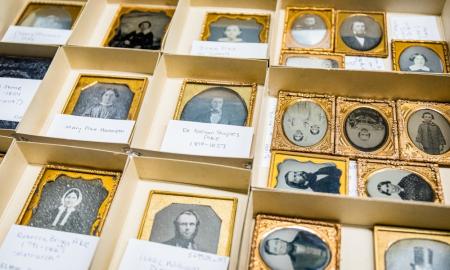
AAS holds a diverse collection of American photography ranging in date from the 1830s to the 1920s.
One-of-a-Kind
Daguerreotypes
Daguerreotypes, the first commercial form of photography, appeared in America around the year 1839. These were produced by first sensitizing a polished silvered copper plate with iodine vapor, and then exposing the plate to light. The image was developed over hot mercury, fixed, and rinsed. This was a direct positive process, meaning that no negatives were produced, and so each daguerreotype is unique. Daguerreotypes can be easily distinguished from other early photographs by their reflective, mirror-like surface.
All daguerreotypes are available through the General Catalog. Much of the collection has been digitized.
Ambrotypes
Ambrotypes became popular in the mid-1850s, and were much less expensive to produce than daguerreotypes. These consist of a collodion image fixed to a glass plate, which, when held up to light, appears negative. To create a positive image, the back of the plate was either painted black or placed against a black background. Like daguerreotypes, ambrotypes are unique objects. The low-contrast images are sometimes difficult to distinguish from cased tintypes, unless the black background material is damaged.
All ambrotypes are available through the General Catalog. Much of the collection has been digitized.
Tintypes
Tintypes, also known as ferrotypes or melainotypes, were produced from the mid-1850s until as late as the mid-1930s. They were less expensive and more durable than either daguerreotypes or ambrotypes, and quickly became the most popular form of early photography. The image consists of a collodion positive fixed to a thin plate of varnished iron. The name "tintype" is derived from the tin shears used to cut the image from a larger sheet. Tintypes were sometimes placed in cases similar to those of daguerreotypes and ambrotypes to give them a more expensive look, but because of their thinness, they were more often placed in small albums or cut to fit jewelry. Though similar in appearance to ambrotypes, they are generally lighter, and will attract a small magnet.
All tintypes are available through the General Catalog. Much of the collection has been digitized.
Negative-to-Positive Process
Cartes-de-Visite
The most popular photographic format in the second half of the nineteenth century, cartes-de-visite measure approximately 2 ½ by 4 inches. Most served as mementos of family and friends, though beginning in the 1860s Americans also collected cartes-de-visite of prominent public figures and views.
A portion of the collection has been fully digitized and cataloged and may be searched in the General Catalog.
The remaining cartes-de-visite many be accessed through an inventory, listing the sitter (main entry), photographer, and photographer's address, available as an Excel spreadsheet.
Cartes-de-visite are included included in the following collection:
- Photographs of Indigenous Peoples (illustrated)
Cabinet Cards
After 1865, the cabinet card gained popularity in the United States. Larger than a cartes-de-visite, the 4" x 6" images could be displayed in the home or preserved in albums. Photography studios offered this format which was popular with families and groups. Theatrical performers used cabinet cards to promote themselves and their performances.
Cabinet cards are included included in the following collections:
- Photographs Actors and Performers (name list)
- Photographs of Indigenous Peoples (illustrated)
- Worcester Portrait Photographs (name list)
Photograph Albums
To meet the demand of a public eager for photographs, book tradespeople quickly developed albums with blank slotted pages to accommodate photograph collections. Albums were designed for various formats including cartes-de-visite and cabinet cards. The collection includes albums made by military regiments, schools, families, and travelers.
The photograph albums have been fully cataloged in the General Catalog and a portion of the collection has been digitized.
Stereographs
The Antiquarian Society houses one of the country's largest collections of early American stereographs, an early form of three-dimensional photograph. Stereographs were a major vehicle for popular education and entertainment in the latter part of the nineteenth century.
Glass Plate Negatives
Due to the extreme fragility of nineteenth century glass plate negatives, the collections may only be accessed digitally. The work of both amateur and professional photographers who used glass plates are represented in the collection. Selections include:
- Photographs of 17th and 18th Century Structures in Massachusetts (illustrated)
- Theodor Clemens Wohlbrück Photographs (illustrated)
- Photographs of the New England Fair by B.T. Hill (illustrated)
Twentieth Century Photography
- Photographic postcard collection
- Farber Gravestone Collection (illustrated)
- A collection of photographs given by Thomas Dailey in 2018 depicting his ancestors of Bridgeport, Connecticut, has been digitized, and includes a copy of his compiled genealogy, available here.
Resources
- Fixed in Time (2014) by Sean William Nolan
This guide to daguerreotype, ambrotype and tintype mats and cases is available as a pdf.